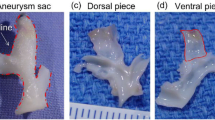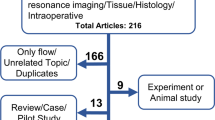Abstract
Intracranial aneurysms are pathological enlargements of brain arteries that are believed to arise from progressive wall degeneration and remodeling. Earlier work using classical histological approaches identified variability in cerebral aneurysm mural content, ranging from layered walls with intact endothelium and aligned smooth muscle cells, to thin, hypocellular walls. Here, we take advantage of recent advances in multiphoton microscopy, to provide novel results for collagen fiber architecture in 15 human aneurysm domes without staining or fixation as well as in 12 control cerebral arteries. For all aneurysm samples, the elastic lamina was absent and the abluminal collagen fibers had similar diameters to control arteries. In contrast, the collagen fibers on the luminal side showed great variability in both diameter and architecture ranging from dense fiber layers to sparse fiber constructs suggestive of ineffective remodeling efforts. The mechanical integrity of eight aneurysm samples was assessed using uniaxial experiments, revealing two sub-classes (i) vulnerable unruptured aneurysms (low failure stress and failure pressure), and (ii) strong unruptured aneurysms (high failure stress and failure pressure). These results suggest a need to refine the end-point of risk assessment studies that currently do not distinguish risk levels among unruptured aneurysms. We propose that a measure of wall integrity that identifies this vulnerable wall subpopulation will be useful for interpreting future biological and structural data.







Similar content being viewed by others
References
Austin, G., S. Fisher, D. Dickson, D. Anderson, and S. Richardson. The significance of the extracellular matrix in intracranial aneurysms. Ann. Clin. Lab. Sci. 23(2):97–105, 1993.
Broderick, J. P., R. D. Brown, L. Sauerbeck, R. Hornung, J. Huston, D. Woo, C. Anderson, G. Rouleau, D. Kleindorfer, M. L. Flaherty, I. Meissner, T. Foroud, E. C. J. Moomaw, and E. S. Connolly. Greater rupture risk for familial as compared to sporadic unruptured intracranial aneurysms. Stroke 40:1952–1957, 2009.
Canham, P. B., and G. G. Ferguson. A mathematical model for the mechanics of saccular aneurysms. J. Neurosurg. 17:291–295, 1985.
Cebral, J. R., and H. Meng. Counterpoint: realizing the clinical utility of computational fluid dynamics—closing the gap. AJNR Am. J. Neuroradiol. 33(3):396–398, 2012.
Cebral, J. R., F. Mut, J. Weir, and C. Putman. Quantitative characterization of the hemodynamic environment in ruptured and unruptured brain aneurysms. AJNR Am. J. Neuroradiol. 32(1):145–151, 2011.
Cebral, J. R., and M. Raschi. Suggested connections between risk factors of intracranial aneurysms: a review. Ann. Biomed. Eng. 41:1366–1383, 2013.
Costalat, V., M. Sanchez, D. Ambard, L. Thines, N. Lonjon, F. Nicoud, H. Brunel, J. P. Lejeune, H. Dufour, P. Bouillot, J. P. Lhaldky, K. Kouri, F. Segnarbieux, C. A. Maurage, K. Lobotesis, M. C. Villa-Uriol, C. Zhang, A. F. Frangi, G. Mercier, A. Bonafé, L. Sarry, and F. Jourdan. Biomechanical wall properties of human intracranial aneurysms resected following surgical clipping (IRRAs Project). J. Biomech. 44(15):2685–2691, 2011.
Frösen, J., A. Piippo, A. Paetau, M. Kangasniemi, M. Niemelä, J. Hernesniemi, and J. Jääskeläinen. Remodeling of saccular cerebral artery aneurysm wall is associated with rupture: histological analysis of 24 unruptured and 42 ruptured cases. Stroke 35(10):2287–2293, 2004.
Frösen, J., R. Tulamo, A. Paetau, E. Laaksamo, M. Korja, A. Laakso, M. Niemelä, and J. Hernesniemi. Saccular intracranial aneurysm: pathology and mechanisms. Acta Neuropathol. 123(6):773–786, 2012.
Haykowsky, M. J., J. M. Findlay, and A. P. Ignaszewski. Aneurysmal subarachnoid hemorrhage associated with weight training: three case reports. Clin. J. Sport Med. 6(1):52–55, 1996.
Hill, M., X. Duan, G. Gibson, S. Watkins, and A. Robertson. A theoretical and non-destructive experimental approach for direct inclusion of measured collagen orientation and recruitment into mechanical models of the artery wall. J. Biomech. 45(5):762–771, 2012.
Humphrey, J. D., and P. B. Canham. Structure, mechanical properties, and mechanics of intracranial saccular aneurysms. J Elasticity 61:49–81, 2000.
Juvela, S., M. Porras, and K. Poussa. Natural history of unruptured intracranial aneurysms: probability of and risk factors for aneurysm rupture. J. Neurosurg. 108(5):1052–1060, 2008.
Kadirvel, R., Y. H. Ding, D. Dai, H. Zakaria, A. Robertson, M. Danielson, D. Lewis, H. Cloft, and D. Kallmes. The influence of hemodynamic forces on biomarkers in the walls of elastase-induced aneurysms in rabbits. Neuroradiology 49(12):1041–1053, 2007.
Kallmes, D. F. Point: CFD—computational fluid dynamics or confounding factor dissemination. AJNR Am. J. Neuroradiol. 33(3):395–396, 2012.
Kelly, P. J., J. Stein, S. Shafqat, C. Eskey, D. Doherty, Y. Chang, A. Kurina, and K. L. Furie. Functional recovery after rehabilitation for cerebellar stroke. Stroke 32(2):530–534, 2001.
Krings, T., D. M. Mandell, T. R. Kiehl, S. Geibprasert, M. Tymianski, H. Alvarez, K. G. TerBrugge, and F. J. Hans. Intracranial aneurysms: from vessel wall pathology to therapeutic approach. Nat. Rev. Neurol. 7(10):547–559, 2011.
Lall, R., C. Eddleman, B. Bendok, and H. Batjer. Unruptured intracranial aneurysms and the assessment of rupture risk based on anatomical and morphological factors: sifting through the sands of data. Neurosurg. Focus 26(5):E2, 2009.
MacDougall, J. D., D. Tuxen, D. G. Sale, J. R. Moroz, and J. R. Sutton. Arterial blood pressure response to heavy resistance exercise. J Appl Physiol 58:785–790, 1985.
Morita, A., S. Fujiwara, K. Hashi, H. Ohtsu, and T. Kirino. Risk of rupture associated with intact cerebral aneurysms in the Japanese population: a systematic review of the literature from Japan. J. Neurosurg. 102(4):601–606, 2005.
Morita, A., T. Kimura, M. Shojima, T. Sameshima, and T. Nishihara. Unruptured intracranial aneurysms: current perspectives on the origin and natural course, and quest for standards in the management strategy. Neurol. Med. Chir. 50(9):777–787, 2010.
Rinkel, G., M. Djibuti, A. Agra, and J. V. Gijn. Prevalence and risk of rupture of intracranial aneurysms: a systematic review. Stroke 29:251–256, 1998.
Robertson, A. M., M. R. Hill, and D. Li. Structurally motivated damage models for arterial walls—theory and application. In: Modelling of Physiological Flows, Modeling, Simulation and Applications, Vol. 5, edited by D. Ambrosi, A. Quarteroni, and G. Rozza. New York: Springer, 2011.
Robertson, A. M., and P. N. Watton. Computational fluid dynamics in aneurysm research: critical reflections, future directions. AJNR Am. J. Neuroradiol. 33(6):992–995, 2012.
Robertson, A. M., and P. N. Watton. Mechanobiology of the arterial wall, chap 8. In: Transport in Biological Media, edited by S. Becker, and A. Kuznetsov. New York: Elsevier, 2013, pp. 275–347.
Ropper, A. H., and N. T. Zervas. Outcome 1 year after SAH from cerebral aneurysm. Management morbidity, mortality, and functional status in 112 consecutive good-risk patients. J. Neurosurg. 60:909–915, 1984.
Sanchez, M., D. Ambard, V. Costalat, S. Mendez, F. Jourdan, and F. Nicoud. Biomechanical assessment of the individual risk of rupture of cerebral aneurysms: a proof of concept. Ann. Biomed. Eng. 41:28–40, 2013.
Schievink, W. I., J. M. Karemaker, L. M. Hageman, and D. J. van der Werf. Circumstances surrounding aneurysmal subarachnoid hemorrhage. Surg. Neurol. 32(4):266–272, 1989.
Schmid, H., P. N. Watton, M. M. Maurer, J. Wimmer, P. Winkler, Y. K. Wang, O. Röhrle, and M. Itskov. Impact of transmural heterogeneities on arterial adaptation: application to aneurysm formation. Biomech. Model Mechanobiol. 9:295–315, 2010.
Scott, S., G. G. Ferguson, and M. R. Roach. Comparison of the elastic properties of human intracranial arteries and aneurysms. Can. J. Physiol. Pharmacol. 50:328–332, 1972. doi:10.1139/y72-049.
Stehbens, W. E. Pathology of the Cerebral Blood Vessels. St. Louis: C.V. Mosby Co., 1972.
Stehbens, W. E. Etiology of intracranial berry aneurysms. J. Neurosurg. 70:823–831, 1989.
Steiger, H. J., R. Aaslid, S. Keller, and H. J. Reulen. Strength, elasticity and viscoelastic properties of cerebral aneurysms. Heart Vessels 5:41–46, 1989.
Stemper, B. D., N. Yoganandan, M. R. Stineman, T. A. Gennarelli, J. L. Baisden, and F. A. Pintar. Mechanics of fresh, refrigerated, and frozen arterial tissue. J. Surg. Res. 139(2):236–242, 2007.
The International Study of Unruptured Intracranial Aneurysms Investigators. Unruptured intracranial aneurysms-risk of rupture and risks of surgical intervention. N. Engl. J. Med. 339(24):1725–1733, 1998.
Weir, B., and R. L. Macdonald. Intracranial aneurysms and subarachnoid hemorrhage: an overview. In: Neurosurgery, 2nd ed., edited by R. H. Wilkins, and S. S. Rengachany. New York: McGraw-Hill, 1996, pp. 2191–2213.
Wiebers, D. O., J. C. Torner, and I. Meissner. Impact of unruptured intracranial aneurysms on public health in the united states. Stroke 23:1416–1419, 1992.
Acknowledgments
This work was supported, in part, by a grant from the National Institute of Neurological Disorders and Stroke of the National Institute of Health (1R21NS080031-01A1). We also wish to acknowledge Joshua Selling, a talented undergraduate student at the University of Pittsburgh, for his development and implementation of a meticulous protocol for fiber diameter measurements. The authors wish to thank the Alzheimers Disease Research Center (ADRC) of the University of Pittsburgh and Dr. Julia K. Kofler, Director of the Neuropathology Core of the ADRC for providing the cadaveric human cerebral vessels that were used in this study.
Conflict of interest
None.
Author information
Authors and Affiliations
Corresponding author
Additional information
Associate Editor Gerhard A. Holzapfel oversaw the review of this article.
Rights and permissions
About this article
Cite this article
Robertson, A.M., Duan, X., Aziz, K.M. et al. Diversity in the Strength and Structure of Unruptured Cerebral Aneurysms. Ann Biomed Eng 43, 1502–1515 (2015). https://doi.org/10.1007/s10439-015-1252-4
Received:
Accepted:
Published:
Issue Date:
DOI: https://doi.org/10.1007/s10439-015-1252-4




